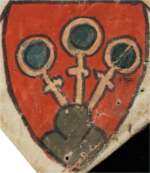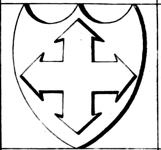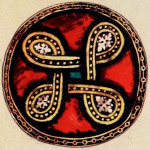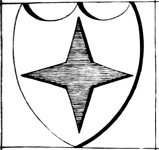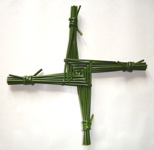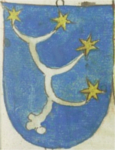alisée

There have been registrations of crosses (and one saltire) alisée, but the only precedents I've found related to them are on crosses alisée formy, which have been disallowed.
ankh / crux ansata

ankh from the temple of Edfu
detail from a photo by Rémih, available under a Creative Commons Attribution Sharealike 3.0 license
Note: This ankh was carved long before the Middle Ages began, but on a temple which may well have been completely buried throughout the Middle Ages and Renaissance.
Gules, three Latin crosses couped Or each conjoined at the chief to an annulet Or voided azure issuant from a trimount vert.
Schweizerisches Nationalmuseum AG 2760

ankh drawn by Khevron Oktavii Tikhikovich Vorotnikov, used by his permission.
"An ankh (or crux ansata) is accepted for use in SCA heraldry, even though it is not a period heraldic charge, as it is a straightforward variant of a Latin cross." (February, 2003 LoAR)
An ankh is substantially different from a cross moline (June, 1996 LoAR) and significantly different from a Celtic cross (September, 2004 LoAR).
A cross avellane is "at least [distinctly changed]" from a crux ansata patty. (June, 2015 LoAR)
cross arrondi
color-corrected detail from a photo of a portion of the Bayeux Tapestry that is in the public domain
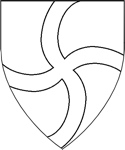
"The cross arrondi is not a period,heraldic cross; it is based on the symbols depicted on some of the shields on the Bayeux Tapestry, so we cannot use our standards of comparing two period styles of cross. Since we sometimes see period examples of crosses drawn arrondi when they are intended to be plain crosses throughout, we will not grant difference for a cross versus a cross arrondi." (January, 2009 LoAR)
"There is a step from period practice for the use of a cross arrondi." (June, 2016 LoAR)
cross barby
cross barby
Volume III of William Berry's 1828 Encyclopædia Heraldica, Plate XXXIII
". . .[T]he cross barby is the outlawed symbol of the white supremacist movement in Hungary, similar to the use of the swastika/fylfot in Germany. . .." (May, 2011 LoAR)
"Any submitter wishing to register this charge after the December 2011 Laurel meeting must provide documentation that it is, in fact, a period charge." (May, 2011 LoAR)
A cross barby is substantially different from a cross formy quadrate (September, 2007 LoAR).
A cross barby is significantly but not substantially different from a cross formy (September, 2002 LoAR).
A cross barby is not substantially different from a cross potent (September, 2007 LoAR).
Bowen cross

a sketch of arms incorporating squared-off Bowen knots from William Fellow's 1530 heraldic visitation of Wales (Coll. Arms H 8, folio 22v)
Thomas Woodcock and John Martin Robinson's 1988 The Oxford Guide to Heraldry, Page 149
Bowen knot on a boss from a 14th century stained glass window in the south choir aisle, St. Ouen, Rouen
painted by Lawrence B. Saint in 1911 for Stained Glass of the Middle Ages in England & France, Plate XXVII

Bowen cross
drawn by Khevron Oktavii Tikhikovich Vorotnikov, used by his permission.
"A Bowen cross is a Bowen knot rotated 45 degrees to be in cross, with the loops straightened into straight lines and right angle bends. It looks like five mascles conjoined in cross." (August, 1980 LoAR)
". . .in armory with a <charge> within a Bowen knot, the Bowen knot is the primary charge and the <charge> is secondary." (August, 2005 LoAR)
It's not a Bowen cross (or a Bowen knot) if it's got elliptical arms with pointed ends and lacks a gap in the center. (March, 2010 LoAR).
A Bowen cross is substantially different from a cross patonce (September, 2004 LoAR), a cross crosslet (October, 2006 LoAR), and a fret (December, 1995 LoAR), and significantly different from a cross formy (May, 1995 LoAR).
A Bowen cross is not significantly different from a bowen knot crosswise (April, 2004 LoAR) or a cross of five mascles (August, 2006 LoAR).
A Bowen cross and a Bowen knot are too similar to appear in the same piece of armory. (August, 2013 LoAR)
Note: There are also multiple registrations of Bowen knots crosswise, which differ from Bowen crosses only in that their loops aren't squared off.
Canterbury cross
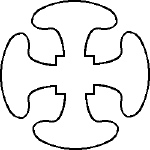
The term "Canterbury cross" was coined by Baldwin of Erebor to describe what could also be blazoned "[a cross] patty potent globical quadrate" (April, 1986 LoAR).
A Canterbury cross is significantly different from a cross patty and a cross potent quadrate (October, 1994 LoAR).
Celtic cross

the Cross of Muiredach, 10th c. C.E.
detail from a photo by Matteo Corti, available under a Creative Commons Attribution Sharealike 3.0 license
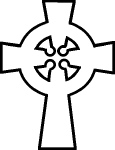
"Celtic crosses are allowed in SCA armory because they are artifacts found in Great Britain and Ireland.. . .Extant examples of stone Celtic crosses have three things in common: wide arms which are straight or slightly tapered, with couped ends; semi-circular cutouts at each of the four angles at which the arms meet in the center; and an annulet that is thinner than the arms, centered on the central axes of the cross, with all four arms of the cross extending beyond the annulet. Artifacts following this pattern are found in both Latinate and equal-armed varieties. This form of Celtic cross will continue to be registerable. Crosses that do not have these three features are not Celtic crosses, and must be documented and defined separately." (cover letter to the July, 2018 LoAR)
"Celtic crosses are Latin (with the lower limb longer than the others) by definition." (June, 2008 LoAR)
"A true Celtic cross has the 'annulet' clearly conjoined with the limbs of the cross, not fretted with it." (November, 1989 LoAR) A cross potent throughout interlaced with an annulet, is, however, a registrable period motif. (cover letter to the July, 2018 LoAR)
"Whether or not the arms of an equal-armed Celtic cross are drawn potent is artistic license." (February, 2007 LoAR)
A Celtic cross is a period artifact, and therefore the use of one on armory is not a step from period practice (December, 2008 LoAR). However, "forming a Celtic cross formy" is. (July, 2015 LoAR)
A Celtic cross cannot be charged in such a way that its defining characteristics (including the cutouts and annulet) are obscured. (Septmber, 2019 LoAR)
A Celtic cross is significantly different from a Celtic cross
quarter-pierced
(October,
1992 LoAR), an ankh
(September,
2004 LoAR), a Cross of
Calvary
(October,
2008 LoAR), a Latin
cross formy
(December,
2001 LoAR), and a cross crosslet
(December,
1998 LoAR).
A Celtic cross is not significantly different from an equal-armed Celtic cross (May, 1992 LoAR), including one that is formy (February, 1998 LoAR).
There is a distinct change between a Celtic cross and a cross nowy (April, 2016 LoAR).
There is no Distinct Change between a Norse sun cross and an equal-armed Celtic cross. (December, 2015 LoAR)
Coptic cross
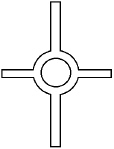
"Coptic crosses as defined in the SCA are the equivalent of a cross couped nowy pierced; that is to say the central circle of the cross is small, between 1/4 and 1/3 of the total width and height of the cross." (August, 2018 LoAR)
a cross ending in four pheons

Note: This cross has a great deal in common with a cross barby.
cross estoile
cross estoile
Volume III of William Berry's 1828 Encyclopædia Heraldica, Plate XXXV
"A cross estoile is a post-period charge. . .," and its use is a step from period practice. (June, 1996 LoAR)
Note: This charge is so far as I can tell indistinguishable from a mullet of four points, which is, in turn, not considered significantly different from a compass star for purposes of conflict checking. (June, 1995 LoAR)
cross potent arched
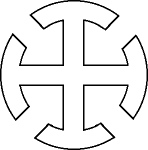
cross potent rebated in annulo

"In plain terms, he wanted an ancient Indo-European sun disk, or fylfot, sometimes known as a swastika, a rounded version thereof. And there was great debate on all sides. It boiled town to this: nobody objected to the sun disk, and everybody objected to the word swastika, and so the blazon was carefully reworded. (KFW, 16 Jan 72 [22], p. 4)" (Precedents of the S.C.A. College of Arms, Volume I)
Note: In 2018, the cross gurgity was ruled unregisterable in all its forms because it was viewed as a variant of a fylfot. I therefore consider it highly unlikely that any attempt to register a cross potent rebated in annulo, which exists explicitly as such a variant, would be successful.
Cross of Saint Brigid
a Brigid's Cross made of rush
photo by Culnacreann available under a GNU Free Documentation license
Note: This is a modern artifact. There is no evidence that anything similar was made in the 16th century or before.
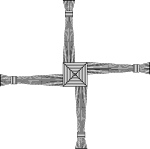
"The question was raised in commentary regarding banning this cross, since it is an SCA invention and relies on its identifiability from the woven straw internal detailing. However, there are period charges that do just that, for instance moons in their plenitude, so we see no reason to ban this cross." (May, 1999 LoAR)
"There is no evidence that a cross of Saint Brigid was used in period, let alone in period heraldry. Therefore, the use of a cross of Saint Brigid is a step from period practice." (February, 2009 LoAR)
"[A] Cross of Saint Brigid throughout is not registerable. Counterchanging a cross of Saint Brigid hampers its identifiability; however, we are uncertain if such counterchanging is a bar to registration and decline to rule on the issue at this time." (September, 2006 LoAR)
A Cross of Saint Brigid is substantially different from a cross clechy (September, 2006 LoAR).
Cross of Samildanach
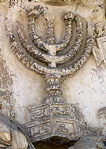
menorah on the Arch of Titus (82 C.E.)
detail from a photo in the public domain
menorah in a medieval Hebrew Bible
Bod. MS Canon Or 94, folio 1r

"The blazon submitted was incomprehensible to anyone who had not seen the emblazon, so when we could not describe it we named it." ( Heraldicon LoAR)
The Cross of Samildanach is explained in the online O&A as "four menorahs in cross".
crux stellata
Azure, a deer's attire argent fesswise each tine conjoined at the tip to a mullet of six points Or.
Herzogin Anna Amalia Bibliothek fol. 220, p. 195
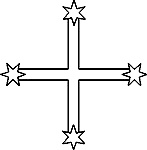
A crux stellata is significantly different from a cross crosslet fleury (July, 1996 LoAR).
